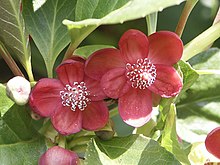| Austrobaileyales Temporal range: Possible Barremian record
| |
|---|---|

| |
| Schisandra rubriflora | |
| Scientific classification | |
| Kingdom: | Plantae |
| Clade: | Tracheophytes |
| Clade: | Angiosperms |
| Order: | Austrobaileyales Takht. ex Reveal[2][3] |
| Families | |
Austrobaileyales is an order of flowering plants consisting of about 100[4] species of woody plants growing as trees, shrubs and lianas. The best-known species is Illicium verum, commonly known as star anise. The order belongs to the group of basal angiosperms, the ANA grade (Amborellales, Nymphaeales, and Austrobaileyales), which diverged earlier from the remaining flowering plants. Austrobaileyales is sister to all remaining extant angiosperms outside the ANA grade.[5][6][7]
The order includes just three families of flowering plants, the Austrobaileyaceae, a monotypic family containing the sole genus, Austrobaileya scandens, a woody liana, the Schisandraceae, a family of trees, shrubs, or lianas containing essential oils, and the Trimeniaceae, essential oil-bearing trees and lianas.[3]
- ^ "Austrobaileyales". www.mobot.org. Retrieved 2023-06-18.
- ^ Cite error: The named reference
APG3was invoked but never defined (see the help page). - ^ a b Cite error: The named reference
APWebwas invoked but never defined (see the help page). - ^ Cite error: The named reference
palmerwas invoked but never defined (see the help page). - ^ Angiosperm Phylogeny: A Framework for Studies of Genome Evolution, Plant Genome Diversity Volume 2, pp. 1–11, 2013, Springer, Pamela S. Soltis and Douglas E. Soltis
- ^ Botanical Journal of the Linnean Society, 2013, 171, 640–654, Structure of the unusual explosive fruits of the early diverging angiosperm Illicium (Schisandraceae s.l., Austrobaileyales), Mikhail S. Romanov, Alexey v. F. CH. Bobrov, and Peter k. Endress.
- ^ Insights into the dynamics of genome size and chromosome evolution in the early diverging angiosperm lineage Nymphaeales (water lilies), Jaume Pellicer, Laura J Kelly, Carlos Magdalena, Ilia Leitch, 2013, Genome, 10.1139/gen-2013-0039